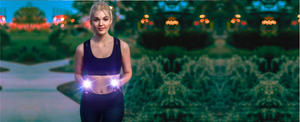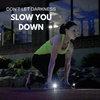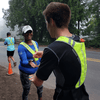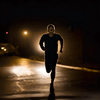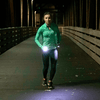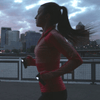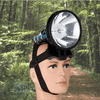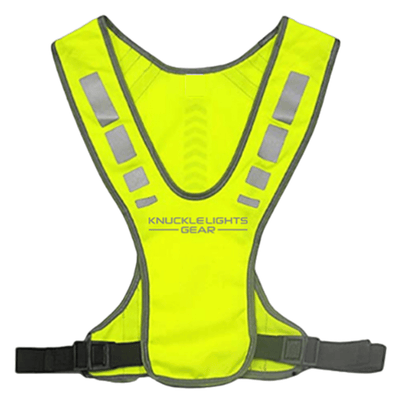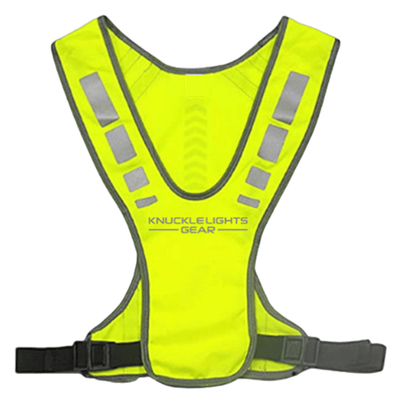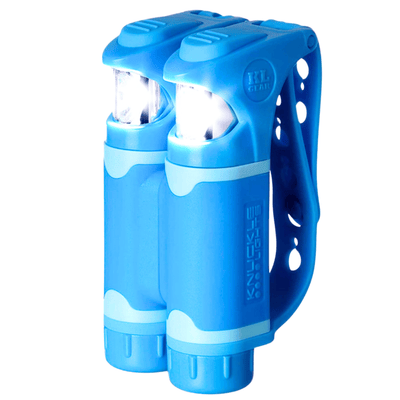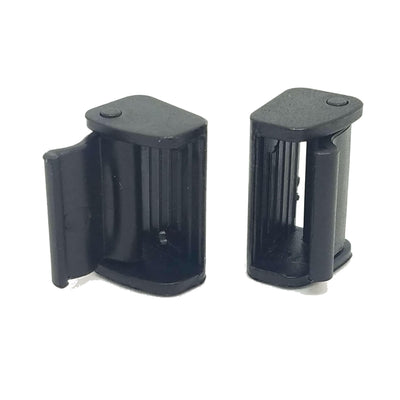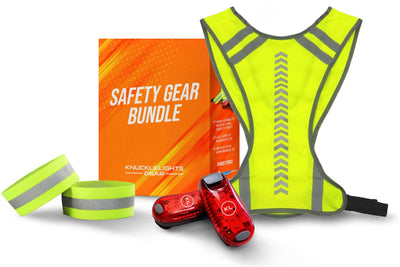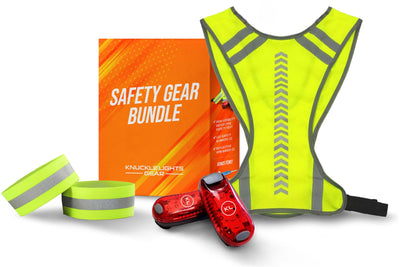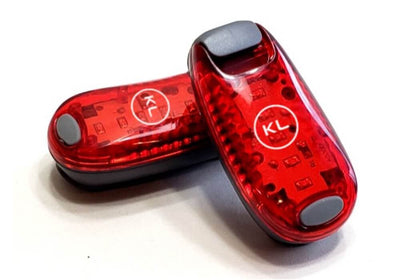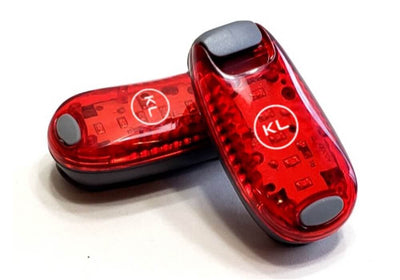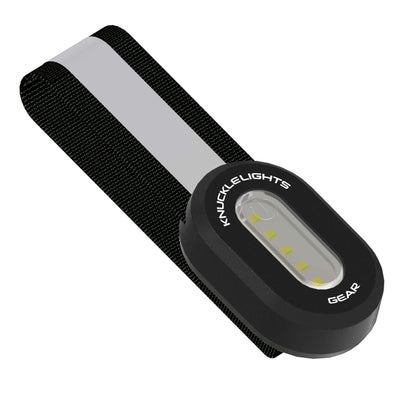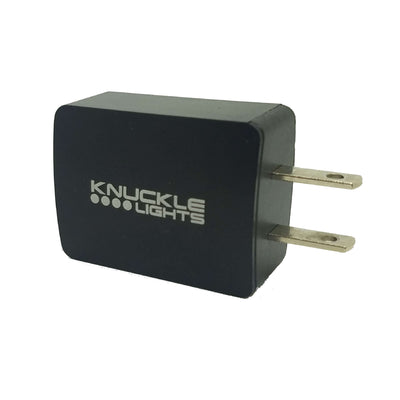Running or walking in the dark is sometimes our only option to be able to fit our fitness routine into our crazy busy lives, but it also comes with many challenges. The lack of daylight means less visibility and therefore more risk. From seeing the road or trail in front of you and being able to avoid potential tripping hazards like ditches, potholes and uneven sidewalks, as well as being seen by motorists, cyclists and even other pedestrians.
Because of the added potential of danger, being cautious about where you run and preparing yourself with the proper gear will make it not only beneficial to your health, but truly enjoyable. If you haven't gone out at night before, you are in for a treat! The stillness and peace that can be found during a run or walk in the dark is a much different experience than in daylight.
Being out late at night or before the sun comes up doesn't need to be intimidating though. There are 3 simple steps that will keep you safe outside in the dark.
Step 1: Be Aware
Running at night requires the right attitude in order to stay safe and it comes down to maintaining your awareness. With a limited field of vision it can be easy to zone-out while running instead of paying attention to your surroundings. Maintaining awareness can be the difference between being struck by a vehicle, tripped by curb, or getting too close to an animal lurking in the darkness.
There are some simple ideas to help you be aware on your night run:
- Familiar Route: night running is not typically the best time to check out new trails or try new streets through your neighborhood. Running your usual course will assure you are familiar with any potential risks so that you can concentrate your awareness on staying safe, instead of overwhelming your senses with new information from a new route. That being said, change up the pattern of your route (run backwards for example) to keep it interesting. This will also change the predictability to deter tracking you by possible nighttime creepers.
- Against Traffic: face traffic as you run so that drivers can clearly see you in plenty of time to give you room on the side of the road if needed. It will also allow you to see vehicles that are coming and not be surprised, so that you have time to react or move out of the way.
-
No Headphones: being able to hear your surroundings is critical for safely running, especially in the dark. A University of Maryland Medical Center
study shows that incidents involving pedestrians being struck by cars or trains using in-ear headphones have increased threefold over the past six years. Bored without music? There are some great products out there to allow you to listen to music safely, including the unique bone-conducting Aftershokz headphones or the multi-use Road Noise reflective vest.

Step 2: Be Prepared
This goes hand in hand with having the right safety gear (see Step 3), but what if something bad does happen when jogging at night? You could have all the proper reflective gear and lights, but it will never fully assure that no incident will occur. This can be said for daytime running as well, anything can happen. Hopefully you will never need it, but the following are important to make sure you are prepared:
-
ID: this can simply be your driver's license, but there are a number of
custom ID attachments or bracelets you can buy, like Road ID, that has your name, blood type and emergency contact information. It is crucial that first responders be able to identify you in the event you should have an accident. If you have proper ID they can quickly contact your family, determine your blood type and any preexisting medical conditions that may be critical to saving your life.

- Phone: needless to say, a phone can come in handy when you find yourself in a pinch, so you can quickly call a family member or emergency services. There are also tracking apps available for your loved ones to follow your progress or locate you by your phone. The free bSafe app will send an emergency message or call designated contacts with a simple push of the button. Additionally, Road ID has an app that allows your emergency contact information to be displayed on your smartphone, even when locked.
-
A Friend (or a Dog!): runs with a friend are not only fun, but may also give you the confidence to get out in the dark. It can be a little more difficult to meet up with a friend at 5:00 AM on a Wednesday morning, but if it is
possible, the buddy system works great to maintain your personal safety. If you have a dog, taking them with you is another great option. I recently wrote about the challenges and benefits of running with a dog, you can read it here. Running groups are another option, with many local running stores coordinating a weekly evening run. Not only do you get a night run into your schedule, there is camaraderie with fellow runners and a chance to meet new people. And often times the runs end with beer. Bonus!

Step 3: Get the Gear
Staying safe during your nighttime run or walk is the number one priority. Having the proper nighttime running gear and equipment to see your path as well as be seen by traffic will go a long ways in assuring your visibility. There is a countless variety of running safety gear and reflective gear available, but it can all be sorted into a few common categories.
-
LED Lights: Knuckle Lights are our obvious favorite here, but you can find
 a wide variety of night running lights that will attach or strap to any part of your body. There are headlamps, flashlights, chest lights, waist lights, shoe lights and more. A simple Amazon search for " Best Running Lights" or "Best Lights for Running at Night" will give you a multitude of options. The key with the light is to be able to see your path and any potential obstacles. Personally, I have tripped over uneven sidewalks in the broad daylight during a run, so adding darkness to the mix is a recipe for injury. Be sure that you have lights that are designed specifically for night time running--I have an article here about how to choose the right light for specifically for running.
a wide variety of night running lights that will attach or strap to any part of your body. There are headlamps, flashlights, chest lights, waist lights, shoe lights and more. A simple Amazon search for " Best Running Lights" or "Best Lights for Running at Night" will give you a multitude of options. The key with the light is to be able to see your path and any potential obstacles. Personally, I have tripped over uneven sidewalks in the broad daylight during a run, so adding darkness to the mix is a recipe for injury. Be sure that you have lights that are designed specifically for night time running--I have an article here about how to choose the right light for specifically for running. -
Blinkers: Knuckle Lights, headlamps and flashlights are ideal for seeing
your path as well being seen by traffic. However, even when carrying a light source, a car approaching from behind may not be able to see the beam of light. There are a number of other safety lights for runners, such as LED blinkers, that can be attached to clothing or a waistband in order to have visibility to drivers or cyclists that may be riding up on you. We have a new unique safety blinker called the Tail Light, check it out here.

-
Reflective Vests and Clothing: there are so many options here to keep you visible. From a 3M reflective strap type or standard utility vest, to high end vests that are customized specifically for running,
 like the Road Noise reflective vest. Many clothing lines, like Nike, Adidas and Under Armor have shirts, jackets and leggings that use reflective material. Keep in mind that any reflective material is passive, which means that, unlike LED lights and blinkers, it only works or is effective if a light source is applied to it. If you have another runner approaching you and they do not have a light source, they will not see you with just a vest or reflective clothing. Bright clothing can also be squeezed into this category, but is not a substitute for lights and reflective material for true night running safety.
like the Road Noise reflective vest. Many clothing lines, like Nike, Adidas and Under Armor have shirts, jackets and leggings that use reflective material. Keep in mind that any reflective material is passive, which means that, unlike LED lights and blinkers, it only works or is effective if a light source is applied to it. If you have another runner approaching you and they do not have a light source, they will not see you with just a vest or reflective clothing. Bright clothing can also be squeezed into this category, but is not a substitute for lights and reflective material for true night running safety. - Personal Safety Equipment: it is something we don't like to think about, but there are potential evildoers out there in the dark, looking for vulnerable people to take advantage of. Runners and walkers are unfortunately in a vulnerable position, as lack of light makes it easier for someone to hide or lurk in the shadows and be concealed with any crime they may intent to commit. There are also less people around who are able to help you should such a situation arise. There is some innovative gear designed to help keep you safe and defend yourself. Pepper spray, the Tiger Claw and the GoGaurded Ring are great tools to ward off attackers. There are also personal alarms that can be attached to you. The LED Lights you are carrying can also be used as a defensive mechanism--one Knuckle Lights user averted an attack last year by blinding the potential perpetrator with our lights.
Bonus Step: Make the Commitment
When you hear the alarm clock go off at 4:30am while facing a busy day ahead, it is hard to get out the door for a run. Similarly, after a full day, the thought of lacing up your running shoes after work instead of just hitting the sack for some well deserved sleep is a constant challenge. Running at night is not as convenient as during the day and is therefore easier to make excuses to skip. But if you make the commitment and understand the benefits, it will go a long way to maintaining your fitness routine.
At the end of the day (pun intended), running at night is not bad and should not be scary if you have the right gear, you're prepared, and you maintain your awareness while out there in the night.
We should all do our part to assure safe night time running and walking, as you can't count on others to be able to see you in the dark. If you are dressed in dark clothing, no lights or blinkers and are unfortunate enough to be struck by a vehicle, it not only changes your life but the life of the driver. We must all take responsibility and make every run a safe run.
Thanks for reading. Stay safe, be seen, and Own The Night!

Dan Hopkins
Founder
Knuckle Lights
